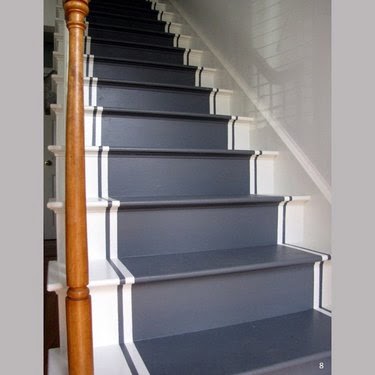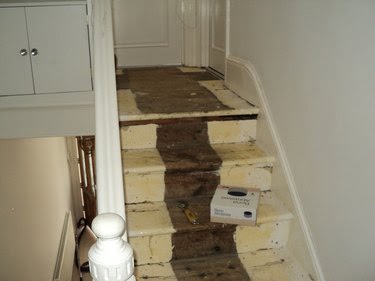Quck answer
Painting stairs is a simple and affordable way to update your home’s interior. To paint stairs, follow these steps:
1. Preparation: Clean the stairs thoroughly and remove any existing paint or varnish. Sand the surface to create a smooth and even base.
2. Priming: Apply a coat of primer to help the paint adhere better and provide a more durable finish. Allow the primer to dry completely before moving on.
3. Painting: Use a high-quality paint specifically designed for floors or stairs. Start by painting the edges and corners with a brush, then use a roller to cover the rest of the stairs. Apply multiple thin coats for better coverage and durability.
4. Finishing touches: Once the paint is dry, consider adding a clear topcoat for extra protection. Finally, touch up any areas that need it and enjoy your newly painted stairs.
Remember to work in a well-ventilated area, use proper safety equipment, and take your time for the best results. Happy painting!
When it comes to painting stairs, it’s common sense to start from the top and work your way down. However, there are other factors to consider. Should you paint or stain the stairs? What type of paint should you use? How should you apply the paint? If the stairs are already painted, do you need to remove the old paint? Lastly, what color and style will complement your home’s décor?

Painted stairs offer various design effects.
Image Credit:
Chebella Interiors
A staircase is made up of four main parts, each requiring separate attention. The treads are the part you step on and need durable, slip-resistant paint. The risers, which are the vertical sections between treads, don’t endure as much wear and tear, so you can use less durable paint and have more color options. The stringers, forming the sides of the staircase, fall into the same category as the risers. Lastly, you may want to paint the railing the same or a different color than the stringers.
Whether you need to strip the existing finish or not, painting stairs requires thorough preparation. In fact, many professionals believe that preparation makes up 90% of a quality job. So grab your palm sander, paintbrush, and respirator, and get ready to showcase your creativity by transforming one of the most noticeable features in your home.
Choosing Paint for Stairs
Painting a staircase can be an exciting design journey.
Image Credit:
Sherwin-Williams
There is no rule stating that you must use different paint colors for the treads and risers, but there is a strong argument in favor of it, especially if you paint the treads a dark color. In low light, contrasting colors on the risers make the treads more visible, reducing the risk of tripping. However, a monochrome color scheme also has its appeal, especially if you choose a light color or the staircase is well-lit.
Durability is essential for the treads to avoid frequent repainting. Most painters recommend using porch and floor enamel for this purpose. This type of finish tends to be glossy due to a higher binder content, which provides wear resistance. Interior or exterior trim enamel is sufficient for other parts of the staircase.
Don’t forget to apply a primer. It is necessary when painting over bare wood and also helps paint adhere better to old varnish and existing paint. Use a high-solids latex- or shellac-based primer.
Tip
If you want a color that is not available in porch and floor enamels at your paint store, you can consider using regular enamel and coating it with a durable clear floor finish. Applying a flat clear finish is also a good way to reduce the sheen of glossy enamel without compromising durability.
Preparing to Paint Stairs

Preparing stairs for painting can be messy, but don’t get discouraged.
Image Credit:
Floor Sanding
Stripping old paint from a staircase before repainting is not always necessary, but there are certain situations where it is the best approach. You should remove old paint if:
- The paint is coming off in flakes, chips, or peels away
- The staircase has multiple layers of old paint
- You want to remove all the paint to get to the bare wood so you can stain it
Warning
If you suspect that any of the paint was applied before the early 1970s, test for lead. You can test it yourself using a kit purchased from a store, but it is safer to collect a sample as close to the wood as possible and send it to a laboratory for testing. If the test shows positive for lead, you can remove the paint using chemicals, but avoid sanding it as it can release lead particles into the air in your home.
You can remove the paint from the stairs using a heavy-duty chemical stripper that is typically used for furniture. This process can be messy. Alternatively, you can consider renting or buying an infrared stripper that uses heat to soften the paint, making it easier to scrape off. Both methods are safe for lead-based paint.
If you have multiple layers of paint on an old wooden or concrete staircase, you can use a lye-based stripper that comes on pre-treated strips. Follow the instructions on the strips, let the stripper sit for 24 hours, and the paint will come off easily. Remember to neutralize the stripper as instructed before applying new paint.
Once you have removed all the paint and reached the bare wood, sand the stairs to remove any remaining paint flecks and to smooth out rough areas. Avoid using a floor sander or belt sander as they can be difficult to control. Instead, use a palm sander with 80-grit or finer sandpaper. Fill any holes that cannot be sanded flat with epoxy filler. If you are prepping concrete stairs, use concrete patch to fill holes and allow the product to dry for at least two days before painting.
Begin with the Railing and Work Your Way Down

As a general rule, start with the railing before moving on to the treads and risers.
Image Credit:
Dulux
When painting the staircase, start from the top and begin with the railing. This way, you won’t have to worry about drips and splatters ruining the finish on the treads and risers. If you cover the treads with cardboard during this step, you won’t need to clean them afterwards.
When it comes to the treads and risers, it is best to do the treads first if you plan on staining them. This will protect the wood from any paint splatters. If you are painting the treads and risers different colors, it is still easier to paint the treads first as they can be easily covered with masking tape once the paint has dried.
Tip
Masking tape can be useful if you want to create stripes or other design effects on your stairs. Applying a base color to the entire surface first and using tape specifically designed for painting will help create crisp lines and minimize seepage. This is especially helpful when painting treads and risers different colors and when masking is required.
Choosing the Right Application Method for Your Painting Job
When you are planning your painting job, it is important to consider the application method you will use. While spraying is a viable option for a single color application, it is crucial to keep in mind that the paint used for the treads is thick and durable, making it best suited for brush application. Although foam brushes do not leave stroke lines, they can be more difficult to control. Therefore, it is advisable to follow the method preferred by professionals, which involves using a bristle brush with a clean, tapered edge for painting stairs and railings.


